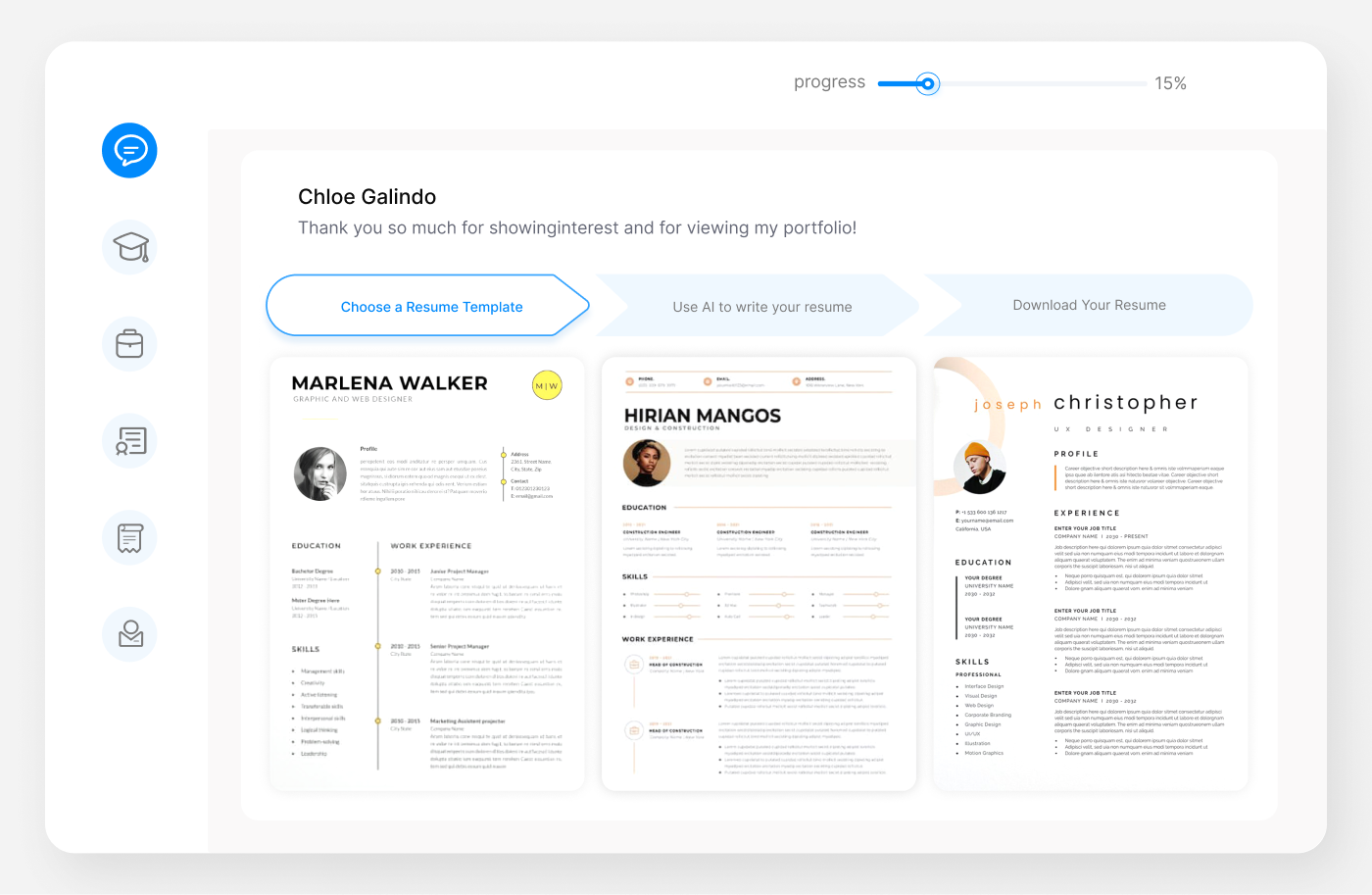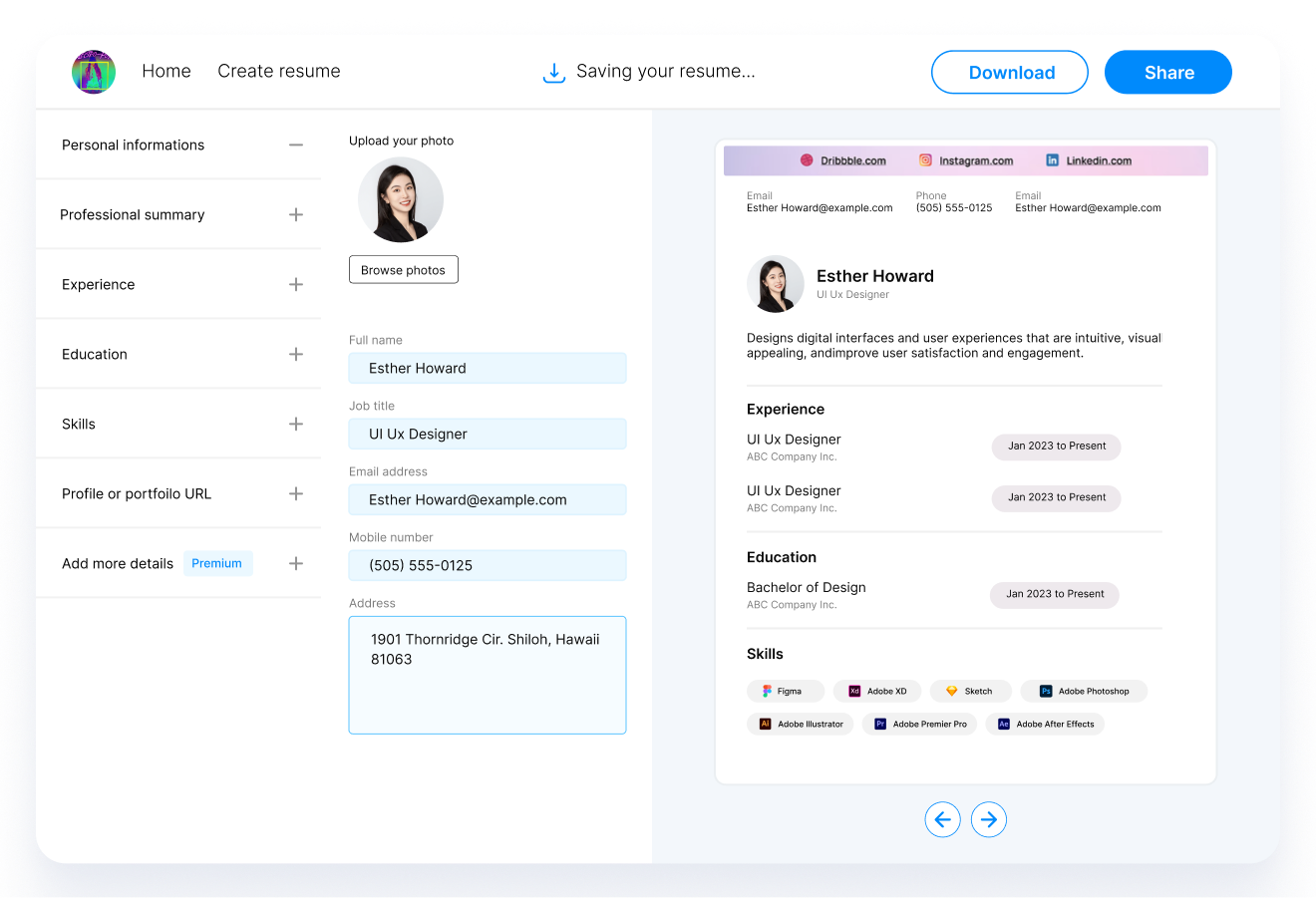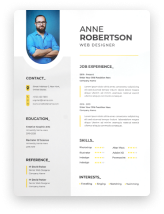Introduction
Overview of the Reverse Chronological Resume
The reverse chronological resume is a time-honored classic in the world of job applications. It's the go-to choice for many job seekers due to its straightforward layout. This resume format lists your work history in reverse order, starting with your most recent position and working backward. It's a direct approach that highlights your professional journey, showcasing how you've climbed the ranks or transitioned between industries.
Importance in the Job Application Process
In today's competitive job market, having a well-crafted resume is crucial. The reverse chronological resume offers a clear timeline of your career, making it easier for recruiters and hiring managers to follow your professional progression. It's particularly effective for those with a solid work history and steady career growth. By presenting your experiences in a reverse chronological order, you're not only aligning with what most employers expect to see, but you're also providing them with a quick and clear understanding of your career trajectory.
Understanding the Reverse Chronological Resume
Definition and Key Features
A reverse chronological resume, often seen as the most traditional resume format, is characterized by listing your work experience in reverse chronological order. This means you start with your most recent job and work backward. The focus is squarely on your employment history, including the names of employers, job titles, dates of employment, and key responsibilities or achievements in each role. This format is particularly effective in showcasing a steady career progression and highlighting your most relevant experiences up front.
Advantages and Appropriateness for Various Career Stages
Advantages:
-
Clarity and Familiarity: Most employers are accustomed to this format, making it easy for them to scan and extract necessary information quickly.
-
Emphasizes Experience: Ideal for those with a strong work history, as it puts your professional experiences front and center.
-
Highlights Career Progression: It's particularly effective in showcasing your upward career trajectory or continuous employment.
Appropriateness for Career Stages:
-
Entry-Level Applicants: While those with limited work experience might find it challenging to fill this type of resume, internships, part-time jobs, and volunteer work can effectively fill the gaps.
-
Mid-Career Professionals: This format is excellent for professionals with a solid employment history, as it highlights their experience and progression in their field.
-
Senior Professionals: For those at the senior level, a reverse chronological resume showcases a long and successful career, emphasizing leadership roles and significant achievements.
Understanding the reverse chronological resume's definition, key features, and its suitability for different career stages helps in tailoring your job application to stand out in the job market.

Components of a Reverse Chronological Resume
Contact Information: Essential Details to Include
Your contact information should be prominently displayed at the top of your resume. This section should include:
-
Name: Your full name, clearly and professionally presented.
-
Phone Number: A reliable number where employers can reach you.
-
Email Address: A professional email address, preferably a combination of your first and last names.
-
Location: Your city and state. Full address is not necessary.
-
LinkedIn Profile: If applicable, include a link to your LinkedIn profile.
-
Portfolio or Website: For professions where a portfolio is relevant.
Objective Statement or Summary: Crafting a Compelling Introduction
The objective statement or summary is a brief section that sits at the top of your resume. It should be tailored to the job you're applying for, highlighting your career goals and key skills that align with the position.
-
Objective Statement: More suitable for entry-level applicants or career changers. It focuses on your career goals and how they align with the company's objectives.
-
Summary: Ideal for experienced professionals. A resume summary emphasizes your most impressive accomplishments and skills.
Work Experience: Structuring Your Professional History and Highlighting Achievements
This is the heart of the reverse chronological resume. Structure it as follows:
-
Job Title: Start with your most recent position.
-
Employer Name and Location: Include the name of the company and its location.
-
Dates of Employment: Month and year are sufficient.
-
Responsibilities and Achievements: Use bullet points to list your responsibilities and achievements. Include quantifiable results where possible, and use action words to add dynamism to your descriptions.
Education Section: Effectively Listing Academic Credentials
List your educational background in reverse chronological order, including:
-
Name of Institution
-
Degree Obtained
-
Graduation Date
-
Relevant Coursework or Honors (optional, but can be beneficial for recent graduates)
Skills and Certifications: Tailoring to the Job and Incorporating Relevant Qualifications
-
Skills: Include a mix of hard and soft skills relevant to the job.
-
Certifications: List any professional certifications that are pertinent to the position you're applying for.
In each of these sections, the key is to present your information clearly and concisely, ensuring that each element adds value to your resume and aligns with the job you're targeting.
Designing Your Reverse Chronological Resume
Layout and Formatting Basics
When designing your reverse chronological resume, start with a clean, straightforward layout. Here's what you should focus on:
-
Margins: Keep them uniform, typically around one inch.
-
Font Type: Choose a professional font like Arial, Calibri, or Times New Roman.
-
Font Size: Your main body text should be 11 or 12 points, with headings slightly larger.
Choosing the Right Font and Size
Your choice of font and size plays a crucial role in the readability of your resume. Stick to classic, professional fonts. Avoid overly stylized fonts as they can detract from the content. Keep your font size legible; your main text should be easy to read without squinting.
Effective Use of White Space for Visual Appeal
White space is essential for preventing your resume from looking cluttered. Adequate spacing between sections, lines, and bullet points improves readability. It guides the reader's eyes through the document in a structured manner.
Balancing Aesthetics with Professionalism
Your resume's design should strike a balance between aesthetic appeal and professionalism. Use subtle lines or color accents if desired, but avoid anything too flashy or distracting. The goal is to make your resume stand out for its content, not its decoration.
A well-designed resume not only reflects your professionalism but also enhances the readability of your content. It's about creating a document that is as pleasing to look at as it is to read.
Customizing Your Resume
Industry-specific Adjustments for Various Sectors
Customizing your reverse chronological resume to suit different industries is key. Here's how you can tailor it:
-
Tech Industry: Emphasize technical skills and relevant software proficiency. Highlight projects and specific technologies you've worked with.
-
Finance and Business: Focus on quantifiable achievements like budget management or revenue growth. Use industry-specific jargon and highlight analytical skills.
-
Creative Fields: Include links to your portfolio. Focus on creative projects and collaborations. Creativity and original ideas should take center stage.
Adapting to Different Career Levels
-
Entry-level: Highlight academic achievements, internships, and relevant coursework. Include volunteer experience and extracurricular activities that demonstrate applicable skills.
-
Mid-Career: Focus on your professional achievements and career progression. Emphasize leadership roles and significant projects you've contributed to or managed.
-
Senior Professionals: Highlight strategic roles, leadership positions, and high-impact decisions. Focus on your experience in shaping company policies or driving growth.
Customizing your resume for your industry and career level ensures that you're presenting the most relevant and compelling information to potential employers.
Common Pitfalls and How to Avoid Them
Overcrowding and Lack of Focus
Avoid cramming too much information into your resume. Stick to relevant experiences and accomplishments. Having a focused and tailored resume is more effective than including every detail of your career history.
Keeping Content Concise and Relevant
Be concise in your descriptions. Use bullet points to break down information into digestible pieces. This helps in maintaining the reader's interest and ensures that your key achievements stand out.
Avoiding Generic Descriptions and Clichés
Stay away from overused phrases like "team player" or "hard worker." Instead, demonstrate these qualities through specific examples and achievements. Use action verbs to start each bullet point, making your responsibilities and achievements more dynamic and impactful.
By avoiding these common pitfalls, your resume will be more effective in capturing the attention of recruiters and hiring managers.
Making Your Resume Stand Out
Supplementing with Cover Letters and References
To make your resume stand out, consider these additions:
-
Cover Letters: A well-written cover letter can make a significant difference. It's an opportunity to explain in more detail why you're the ideal candidate for the job.
-
References: While not always necessary to include in your resume, having a list of professional references ready is a good practice. Choose references who can vouch for your skills and experiences relevant to the job you're applying for.
Leveraging Technology in Resume Building
-
Resume Builder Tools: Utilize online resume builders for professional templates and formatting. These tools often come with suggestions for phrasing and organizing your content effectively.
-
LinkedIn Profiles: Many employers check LinkedIn profiles. Ensure yours is up-to-date and reflects the same information as your resume.
ATS-friendly Formatting Tips
Many companies use Applicant Tracking Systems (ATS) to screen resumes. To ensure your resume is ATS-friendly:
-
Use Standard Headings: Like "Work Experience," "Education," and "Skills."
-
Avoid Tables and Graphics: These can confuse the ATS.
-
Use Keywords: Incorporate relevant keywords from the job description.
Making your resume stand out not only involves great content but also being mindful of the additional elements and technological aspects that can enhance your job application.
Chronological Resume Templates and Writing Tips
Resume Structure
Here's a simple structure for a reverse chronological resume:
-
Name and Job Title: Clear and at the top.
-
Contact Information: Phone, email, LinkedIn.
-
Resume Summary or Resume Objective: Depending on your experience level.
-
Professional Experience: Listed in reverse chronological order.
-
Education: Especially important for recent graduates or those with less work experience.
-
Skills: Tailored to the job you're applying for.
-
Additional Sections: Like certifications, languages, or volunteer work.
Writing Tips
-
Quantify Achievements: Use numbers and statistics to demonstrate your impact.
-
Tailor Your Resume: Customize it for each job application.
-
Proofread: Ensure there are no spelling or grammatical errors.
Using these templates and writing tips as a guide, you can craft an effective reverse chronological resume that showcases your experience and qualifications in the best light.
Chronological Resume Samples and Why They Work
Sample Resume for a New Graduate:
Jane Doe, Marketing Graduate
Contact: 555-1234, janedoe@email.com
LinkedIn: linkedin.com/in/janedoe
Resume Objective:
Recent marketing graduate with a passion for developing innovative marketing strategies. Adept at data analysis and market research, seeking to apply skills in a dynamic marketing role.
Education:
Bachelor of Arts in Marketing
Monash University, Graduated 2023
Internship Experience:
Marketing Intern
Securian Corp Summer 2022
- Assisted in the development of online marketing campaigns, resulting in a 15% increase in online engagement.
Skills:
- Social Media Marketing
- Data Analysis
- Adobe Creative Suite.
Certifications:
- Google Analytics Certified
- Hootsuite Social Media Marketing Certification.
Why It Works: This sample is effective because it emphasizes the candidate's recent education and internship experience, both relevant to the marketing field. The resume objective clearly states career goals and specific skills, making it appealing to potential employers.
Sample Resume for a Managerial Position:
John Smith, Operations Manager
Contact: 555-6789 johnsmith@email.com
LinkedIn: linkedin.com/in/johnsmith
Resume Summary:
Experienced Operations Manager with over 10 years of experience in overseeing daily operational functions in manufacturing. Proven track record of improving efficiency and reducing costs by 20%.
Professional Experience:
Operations Manager
Ashley Manufacturing 2015-Present
- Led a team of 50 employees, successfully implemented process improvements resulting in a 25% increase in productivity.
Education:
MBA
Baylor University, Graduated 2010
Skills:
- Team Leadership
- Process Optimization
- Project Management.
Certifications:
- Certified Lean Six Sigma Green Belt.
Why It Works: This sample is effective because it highlights significant achievements and relevant managerial skills. The summary provides a quick overview of the candidate's extensive experience and expertise in operations management.
General Chronological Resume Template
-
Name and Job Title
-
Contact Information
-
Resume Summary or Resume Objective
-
Professional Experience
-
Job Title
-
Employer Name, Employment Dates
-
Key Responsibilities and Achievements
-
Education
-
Skills
-
Additional Sections (Certifications, Volunteer Work, etc.)
Using these samples and the general template as a guide, candidates can create a compelling chronological resume that effectively communicates their qualifications and experiences to potential employers.
Chronological Resume Examples for 30+ Professions
Please refer to our resume example resource center for specific professions. Each example is tailored to showcase the most relevant skills and experiences for that particular profession, demonstrating how to effectively format and write a resume in a reverse chronological layout.
Advanced Tips and Strategies
Networking and Enhancing Your Resume Through Professional Connections
-
Utilize LinkedIn: Connect with industry professionals and join relevant groups.
-
Attend Networking Events: Make connections that can lead to job opportunities or recommendations.
-
Seek Mentors: Gaining insights from experienced professionals can provide guidance and improve your resume.
Continuous Improvement and Updating Your Resume
-
Stay Updated: Keep abreast of industry trends and update your skills accordingly.
-
Regular Updates: Regularly update your resume to reflect your most recent experiences and achievements.
-
Feedback: Seek feedback on your resume from mentors or professionals in your field.
Key Takeaways
To sum up, a reverse chronological resume is a powerful tool in your job search arsenal. Remember to:
-
Highlight Your Most Relevant Experiences: Focus on what's most relevant to the job you're applying for.
-
Be Clear and Concise: Make it easy for employers to see your value.
-
Customize for Each Application: Tailor your resume to each job description.
By following these guidelines, you can craft a job-winning resume that effectively showcases your skills and experiences.

FAQs
Q1. Is a reverse chronological resume suitable for someone with gaps in their employment history?
A: For those with significant employment gaps, a functional or combination resume might be more appropriate. However, short gaps can often be addressed in your cover letter or interview.
Q2. Can a recent graduate with limited work experience use a reverse chronological resume?
A: Yes, they can focus on internships, part-time jobs, volunteer work, and relevant coursework to fill their resume.
Q3. How important is it to tailor my resume for each job application?
A: It's crucial. Tailoring your resume for each application increases your chances of passing through ATS systems and appealing to the specific needs of the employer.
By keeping these FAQs in mind, you can better understand how to use a reverse chronological resume effectively in your job search.
Recommended Reading









